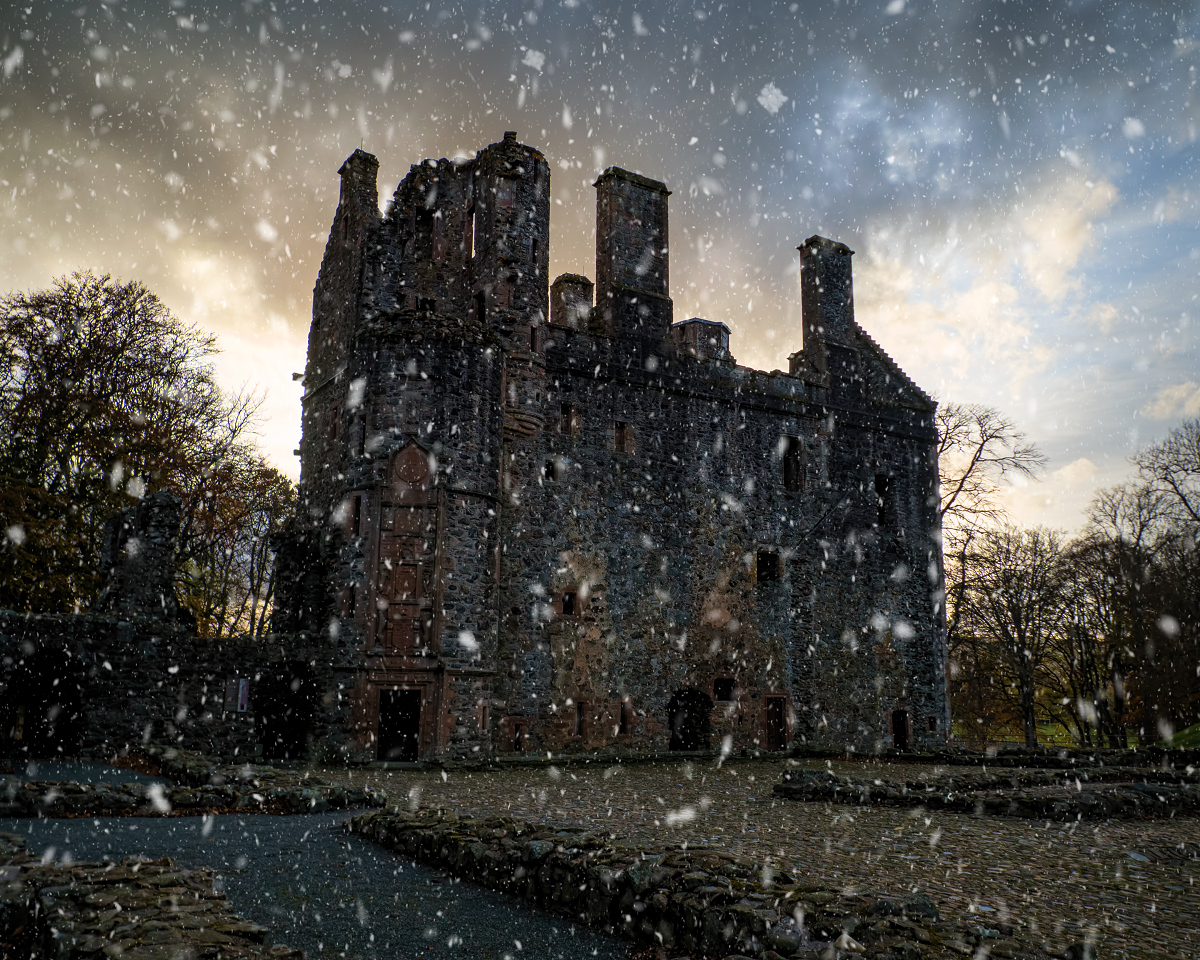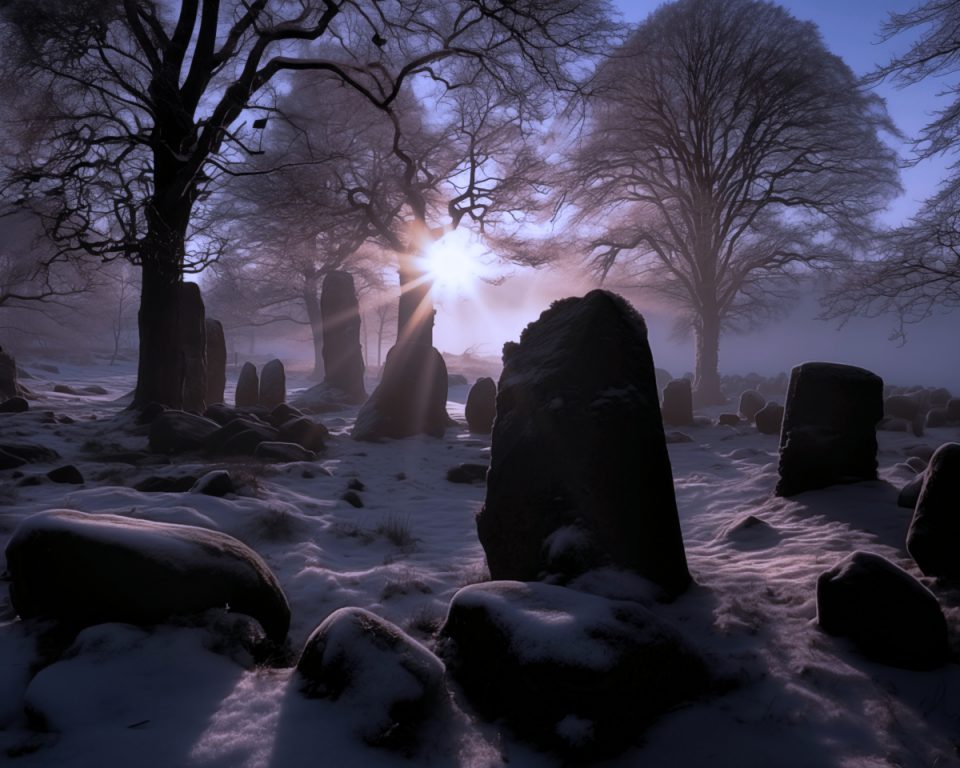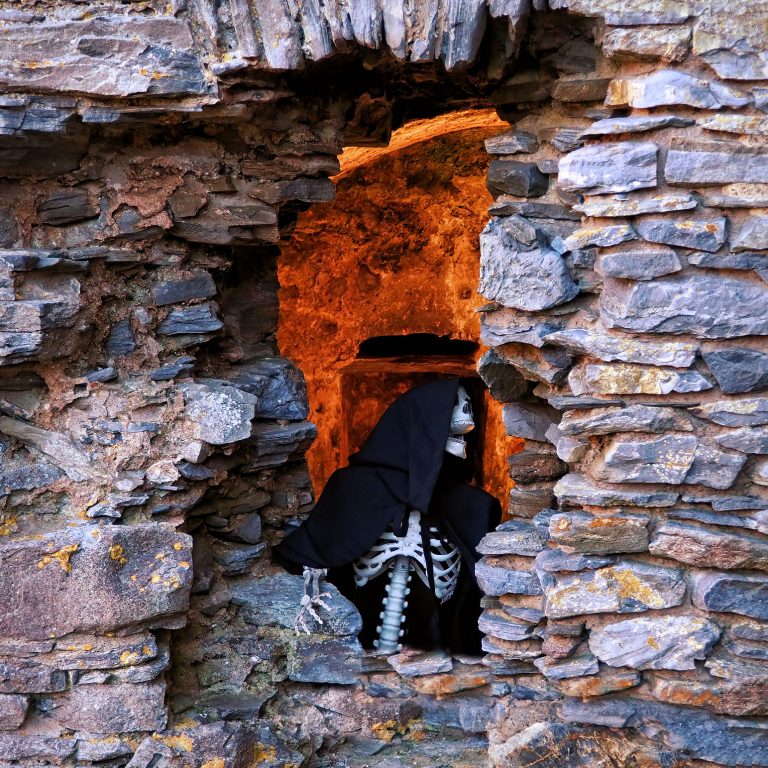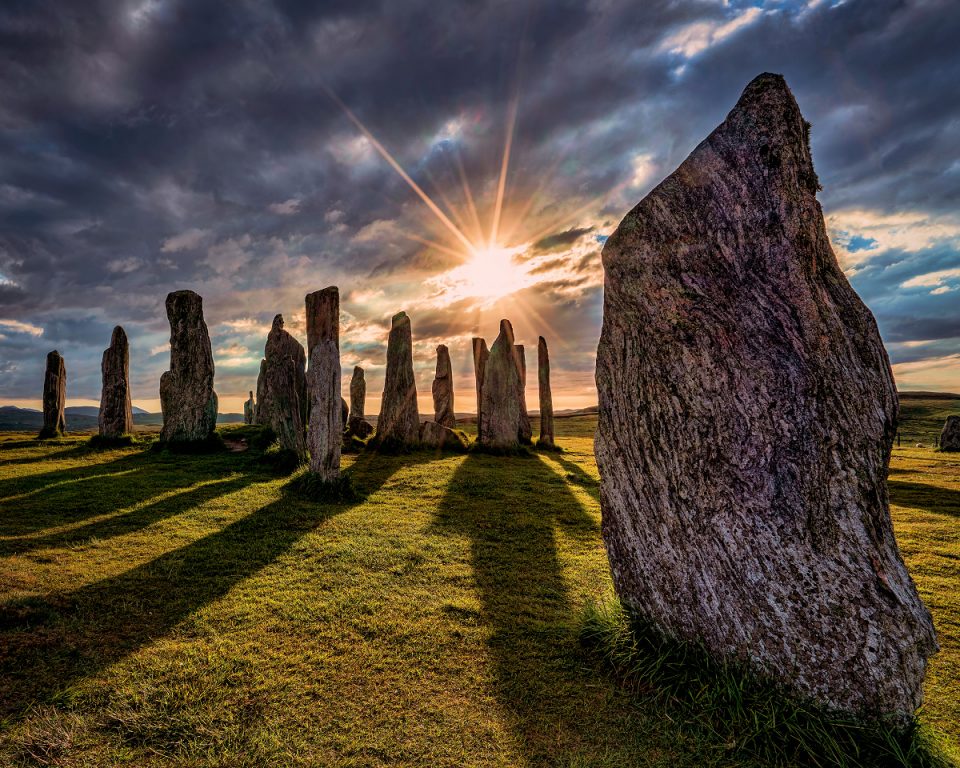Did you know that once upon a time, Christmas was banned in Scotland- by the Kirk? And that Christmas has only recently become a public holiday? However, from before the dawn of time, this time of year has been important to the inhabitants of Scotland. Stone Age Megaliths are aligned to the Winter Solstice. Many of the things we now associate with Christmas have their roots in the ancients ways of the Druids, the erstwhile Priests of the Celts. Even after Christianity arrived in Scotland, this time of the year was known as Yule. Come and join us as we run through the history of Christmas in Scotland.
Stone Age Scotland and the Winter Solstice
The festive period stems from an acknowledgement of the Winter Solstice; the day with the shortest hours of daylight in the year. The Winter Solstice was so important that the Stone Age people built Megaliths aligned to it. During Mesolithic times, it is believed that the inhabitants around Crathes Castle built the world’s first calendar. It was based on the lunar cycle which is 11 days short of a solar year. The early peoples are thought to have used the Winter Solstice to reset their calendar.
Fast forward to Neolithic times. It was during this time that many of our stone circles, henges and chambered cairns were built. We know that the Solstices were important to these people because many of the Megaliths are aligned to them. On the Island of Lewis, the Stones of Calainais are aligned to the Summer Solstice. On the other hand, the Clava Cairns, next to Culloden Battlefield, are aligned to the Winter Solstice. Perhaps the most well known of the winter aligned Megaliths is Maeshowe on Orkney. Maeshowe was built around 2700 BC. For three weeks before and after the Winter Solstice, the setting sun shines down the long entrance passageway into the chambered cairn, casting light onto its far wall.
We do not know exactly why or how Orkney’s prehistoric people acknowledged the Winter Solstice, but it was obviously a time of great significance. After all, some of the stone slabs in the cairn are 30 tonnes in weight! Given that Orkney gets a meagre six hours light at this time of year, I am sure the prospect of the lengthening days was welcomed with open arms! We, at Spooky Scotland, certainly look forward to the long days of Summer during the ‘bleak Midwinter’.
The Festive Season and The Celts
Many of our Christmas traditions have their origin in the Celtic celebration of the winter solstice when the shortest day marked the rebirth of the sun. The Druids would cut mistletoe, a symbol of life, from the sacred oak tree and give it as a blessing. The Roman, Pliny wrote:
“The druids – that is what they call their magicians – hold nothing more sacred than the mistletoe and a tree on which it is growing, provided it is a hard timbered oak … Mistletoe is rare and when found it is gathered with great ceremony, and particularly on the sixth day of the moon….
Hailing the moon in a native word that means ‘healing all things,’ they prepare a ritual sacrifice and banquet beneath a tree and bring up two white bulls, whose horns are bound for the first time on this occasion. A priest arrayed in white vestments climbs the tree and, with a golden sickle, cuts down the mistletoe, which is caught in a white cloak. Then finally they kill the victims, praying to a god to render his gift propitious to those on whom he has bestowed it. They believe that mistletoe given in drink will impart fertility to any animal that is barren and that it is an antidote to all poisons.”
However, it should be noted that Pliny’s writing is not always accurate and is given to exaggeration, especially if it presented the Romans in a favourable light.
The Feuding Seasons
In Celtic mythology, there is a recurring theme of the feud between winter and summer. We see this in the tales of Brìde and the Cailleach. Could the connection between the oak tree, representing summer, and mistletoe representing winter, be another example of this? The early people’s beliefs were closely tied to nature. A little knowledge of the biology of mistletoe might strengthen the idea of the feuding seasons. Mistletoe is parasitic, and in the case of a severe infestation, will kill the host plant. If mistletoe, this winter fruiting plant, was seen to kill the oak, with its summer foliage, would it not be revered for symbolically killing summer?
Yule Fires
The Druids also started the tradition of the Yule log. They believed the sun stood still for twelve days in the middle of winter. During this time a log was lit from the remains of last year’s fire. It was thought to conquer the darkness, banish evil spirits and bring luck for the coming year.
Large scale Yule fires remained a common way to mark the season over the centuries in Scotland, particularly in northern harbour towns and can be seen today in the New Year Fire Festivals in Burghead and Stonehaven.
The Arrival of the Vikings and Yule
The 12-day celebration of Yule was fully embraced by the Viking settlers who arrived in Scotland between the 8th and 15th Centuries. According to Norse mythology, the sun is a wheel that changes the seasons. The word Yule was derived from the word for this wheel: “houl”.
The Viking celebration was devoted to Freyr, the god of Sunshine, who was said to ride across the sky on a golden bristled boar. During the Yule Feast, a boar’s head would be decorated with laurel and rosemary. After the feast, a huge fire would be lit and the men would hold hands and circle the flames with increasing speed calling “Thor with us, Thor and Odin and Hale, Yule ha!”
Many of our Christmas traditions have come down to us from our Viking ancestors: the Christmas tree, the holly wreath which represents the Yule wheel and even Santa Claus. During the Yule celebrations someone would be selected to dress up as ‘old man winter,’ a white-bearded man dressed in a hooded fur coat, thought to represent Odin. Old Man Winter would ride a sleigh pulled by goats.
The Coming of Christianity and the celebration of Christmas
In time, the Celtic peoples were converted to Christianity. Originally the peoples of Scotland belonged to the Celtic Church until the reign of Malcolm Canmore. His wife, the Anglo-Saxon princess, Saint Margaret was largely responsible for bringing Scotland under the auspices of the Roman Catholic Church in the 11th Century. The Christian Churches owed much of their success to the fact that they aligned the Christian calendar and its Holy days with many of the former pagan festivals. Thus Christ’s Mass was celebrated at the beginning of Yuletide and Epiphany, the day when the Wise Men’s arrival was celebrated, was aligned to the end of the Yule period.
Many of the old traditions were recycled and the symbolism was given a new meaning. Christmas Day was primarily a religious festival celebrated with feasts, gifts and games. But December 25 also signified the start of the Daft Days, or the 12 days of Yule, which ran until Epiphany on January 6, or Uphalieday, and allowed for a period of merriment, frivolity and excess.
Christmas and Daft Days
In the early 1500s, the festive period was characterised by feasting, processions and the election of “Boy Bishops” and other “lords of misrule”. This later to become known here as “the Daft Days” – the “Twelve Days” between Christmas Eve and Uphalieday, or Twelfth Night, on 6 January.
In Edinburgh, Christmas Day would begin officially with the celebration of Mass, amid much pomp, attended by the king and courtiers. Afterwards, citizens on the High Street would provide a torchlight escort for the Provost as he walked home from church.
During Mary Queen of Scots’ reign, the Twelfth Night revels, at Holyrood House, included putting a bean in a cake. Whoever found the bean became the Bean King or Queen for a day.
The Folklorist F Marian MacNeil, stated:
“Yule at Old Holyrood was spent in feasting, music and dancing, ending with the mimic pageantry of Twelfth Night.”
She said James VI “was no less insistent than his mother, Mary, on maintaining the festival, and in 1600 Christmas was ‘solemnellie keepit by the court with shooting of cannons out of the Castell of Edinburgh, and other signs of joy'”.
Christmas and the Protestant Reformation
However, by the mid-16th century, the Holyrood festivities were the exception. In 1560 Scotland split from the Catholic Church in a period known as the Protestant Reformation. The split provoked a change in religious thought. Anything seen to reek of “papishness” or idolatry was swept away in a grim excess of reforming zeal. Any activity that could be seen as extravagant, or as celebrating superstitious ideals, was heavily frowned upon; this included the celebration of Yule. Those caught celebrating it were publically rebuked.
In 1583 the Glasgow Kirk at St Mungo’s Cathedral or Glasgow Cathedral ordered the excommunication of those who celebrated Yule. Meanwhile, elsewhere in Scotland, even singing a Christmas carol was considered a serious crime. On 27 December 1583, five people in Glasgow were brought before the kirk session, a local church court. They were ordered sternly to make public repentance for “keeping Yule”. The “baxters” or bakers of the city were expected to report anyone to whom they had supplied “Yule bread”. On Christmas 1605, five Aberdonians were brought before the kirk session for going through the town “maskit and dancing with bellis”.
In 1640 an Act of Parliament of Scotland made the celebration of Yule illegal. This ban was officially repealed in 1712, but the Church continued to frown upon the festive celebrations. Punishments for celebrating Yule were harsh, and there was no public holiday for the Scottish people on Christmas Day.
The banishment of Christmas meant that the Scots would focus their celebration around Hogmanay or New Year’s Eve. It explains why Hogmanay is by far the biggest celebration in the Scottish calendar: from fireball swingin’ in Stonehaven to the firework displays above the huge crowds at Edinburgh Castle.
Christmas and the First Christmas Card
The invention of the first Christmas card is credited to a Leith printer, Charles Drummond. During Christmas 1841, Drummond issued a card which depicted a cheerful, chubby character and bore the message “A Gude New Year And Mony o’ Them”. However, he attributed the idea to his friend, Thomas Sturrock. A couple of years later, the first Christmas cards to specifically mention Christmas by name, were produced in London.
As Christmas took hold in Scotland, Santa Claus became the deliverer of presents. This is in marked contrast to England where Father Christmas delivers the presents.
Christmas in Scotland becomes a Public Holiday
Christmas Day finally became a public holiday in 1958. It wasn’t until in 1974 that Boxing Day became a public holiday as well. People had been accustomed to working on Christmas Day. As recently as 2001 there were threats of strikes when Scottish banks tried to offer their workers English bank holidays: giving workers more time off over Christmas, but less time off at New Year.
Christmas celebrations in Scotland are now on a par with New Year, and the Yuletide celebrations of the rest of the UK and Europe. Edinburgh now hosts its a traditional German Christmas Market each year. Christmas lights are strung up in the high streets of all of the main towns and turkey, stuffing and all the trimmings are served up as Christmas Fayre. However, as Scots, we will put our own unique twist on things with oatmeal stuffing replacing the sage and onion and clootie dumpling replacing Christmas Pudding.
In the last few years, Black Friday has become part of the Christmas lead up. No doubt our Christmas celebrations will continue to evolve in line with the rest of the Western World.
Belated Christmas Greetings
Belated Christmas greetings from all at Spooky Scotland. As they say in Gaelic: “Nollaig Chridheil”. Join us again on Hogmanay when we explore Scotland’s New Year Traditions.




